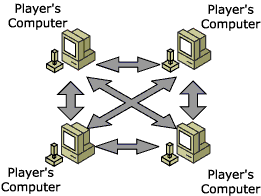|
|
|
|
Peer-to-Peer Topology |
A peer-to-peer game consists of the individual players' computers, connected by network links. Schematically, the topology of a four-player peer-to-peer game looks like:

Gameplay is handled by having each user's game client communicate directly with the other users' clients. For instance, when one user moves, the game client must send three update messages, one to each of the other users' computers.
A peer-to-peer game is normally arranged and launched through a lobby client application that resides on the user's computer. There are two basic ways the lobby client can arrange a session:
Once a session has been arranged and launched, most or all of the messaging will be user to user. If a lobby server is involved, it will only be handling such tasks as updating its list of session members when a player leaves the game, or enabling a new user to request entry to the session. Otherwise, the server stays in the background, and is typically not even aware of most of the messages that are being sent.
Because the server is either non-existent or at least not directly involved with the game play, one user is designated as the game host. They are responsible for handling logistical details such as bringing new players into an ongoing session.
Peer-to-peer games have the advantage of simplicity. All that is needed is a collection of players with game clients, and a way to organize a session. The primary drawback of the peer-to-peer topology is scalability. As the number of users increase, the number of messages needed to facilitate game play increases geometrically. The maximum number of users that can be accommodated depends on the game and the network bandwidth, but is typically no more than thirty.
Send comments about this topic to Microsoft. © Microsoft Corporation. All rights reserved.
Feedback? Please provide us with your comments on this topic.
For more help, visit the DirectX Developer Center